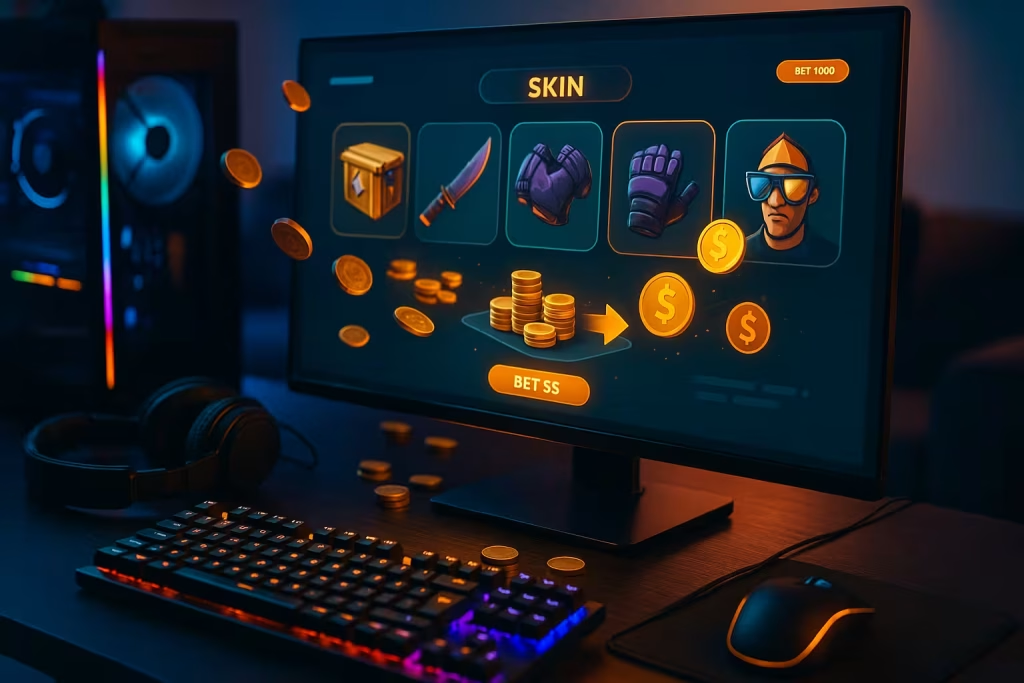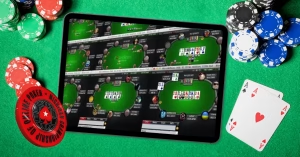The Hidden Revenue Streams of Casino Sites: Skin Bets, Side Bets & Microstakes

Most players assume casino sites make their money the straightforward way — through the house edge. You place your bet, the odds favor the casino just enough, and over time, the house always wins. Simple, right? Not quite.
Behind the scenes, online casinos have quietly built an entirely different set of profit engines that most players never notice. These hidden streams aren’t about big wagers or high rollers — they’re about engagement, psychology, and scale. Think digital skins being wagered like cash, “fun” side bets that secretly carry double the house edge, and micro-wagers so small they fly under your radar but multiply into millions across thousands of players.
It’s a system designed to keep players spinning, clicking, and depositing — often without realizing how much they’re fueling the machine. Today, we’re pulling back the curtain to explore how casino sites really make their money through skin bets, side bets, and microstakes.
The Obvious vs. The Hidden: Where Casino Revenue Really Comes From
Most players think the casino business model is simple: you play, the house edge takes its cut, and that’s how the site makes money. It’s true — the house edge is the foundation of every casino’s profit. But it’s far from the whole story. Modern casino platforms have evolved far beyond just taking a percentage off the top of your bets. They’ve built an ecosystem of secondary and hidden revenue streams that quietly boost profits in ways most players never see.
The “Obvious” Revenue Sources
These are the ones everyone recognizes — the bedrock of casino income:
- 🎲 House Edge: Every game has built-in math ensuring long-term profitability.
- 💳 Rake & Fees: Poker rooms and live dealer tables take a small cut of every pot or entry.
- 🤝 Affiliate Partnerships: Casinos pay (or earn) commissions through referral programs that drive player acquisition.
- 💰 Bonuses & Wagering Requirements: Promotions appear generous but often require high playthrough rates that recycle player funds back into the system.
These are legitimate and transparent — players understand the mechanics and accept them as part of the game.
The “Hidden” Profit Engines
Where things get interesting is in the secondary layers — the quiet, high-margin activities that extend player value far beyond their initial deposit. This includes:
- Skin Betting: Using in-game or cosmetic items as currency for wagering.
- Side Bets: Add-on wagers that feel like harmless fun but carry higher house edges.
- Microstakes Games: Low-risk, high-frequency bets that generate massive engagement and steady returns.
- Cross-Promotion Systems: Players who start in slots may be upsold to sports betting, esports, or casino apps under the same brand.
These mechanisms aren’t inherently bad — they’re smart business. But they’re designed around psychology and repetition, turning small, consistent actions into massive aggregate revenue over time.
The Core Shift: From Bets to Behavior
The biggest difference between the old and new casino models is focus. Traditional casinos profited from the size of bets. Modern online casinos profit from the frequency and behavior of players. Every click, spin, and side bet fuels a data-driven system that optimizes engagement and retention.
It’s not just about what players bet — it’s how often they come back, how long they stay, and how many micro-decisions they make along the way.
Skin Betting: The Digital Gold Rush

The term “skin betting” might sound niche, but it’s a massive element in the modern online casino economy. In essence, skins are virtual items—cosmetic gear, avatars, weapon designs, in-game items—that have real monetary value because they can be traded or converted.
How it works
- A player obtains or buys a skin in a game (say, for a shooter or MMO) with cash or in‐game credits.
- That skin becomes a currency: it can be deposited into a betting platform, used to wager on outcomes (esports, casino games, in-game odds).
- Winnings might be skins again, or cashable tokens.
- Thus a relatively small investment (a $5 skin) can turn into wagering activity far beyond that $5.
Why casinos like it
- Engagement: Users already familiar with skins feel comfortable wagering them; it blurs the line between gaming and gambling.
- Volume: The lower perceived “real-money” barrier encourages more participation and more wagers.
- Novel monetization: Skins open up markets that traditional currency might not reach—especially younger players or those less committed to big cash stakes.
Real-world insight
A 2022 study showed that skin gambling contributes to gambling problems and harms even after controlling for traditional gambling.
Another review found that skin gambling does not always directly lead to traditional cash gambling — but it does appear to directly increase risk of gambling harm.
The pipeline
Imagine: Player spends modest money to get a desirable skin → uses it to wager (low barrier) → wins/loses → keeps playing because the ‘currency’ doesn’t feel like real money → triggers side bets, microstakes, bonuses → larger lifetime value. For the operator, this is a layered loop of engagement and monetization.
Grey market or genius monetization?
Many skin‐betting sites operate in regulatory grey zones—virtual items, trading platforms, cross-border jurisdictions. That means fewer controls, fewer constraints, and potentially higher margins. For operators willing to navigate that complexity, the upside is substantial.
Side Bets: The Addictive Profit Multiplier
Have you ever played a game of blackjack or roulette and seen a side bet like “Perfect Pairs” or “Lucky 7”? On the surface they look like harmless extras. But for casino operators, side bets are a potent profit engine.
What are side bets?
- Additional wagers made on top of the main game.
- Usually optional but framed as “extra excitement,” “bonus chance,” or “super win.”
- Examples:
- “Perfect Pairs” in blackjack: bet that your first two cards will be pair.
- “Dragon Bonus” in baccarat: bet on a big margin.
- Roulette “Lucky 7” side-wager: e.g., next number 7 or combination.
Why they boost revenue
- Larger marginal house edge: Side bets often carry significantly worse odds than the base game. For instance, a standard roulette bet might have a house edge of ~2.7 % (European). A side‐bet may carry 10–15 % or more.
- Increase in average bet size: Players engaging in side bets often bolster the size of their session wagers.
- Multiple bets = multiple profit events: Each extra wager is another revenue event.
- Psychological appeal: “Just one more bonus,” “extra thrill” – players are primed by the game environment.
Example scenario
A player places standard blackjack wagers for a while. The operator introduces a side-bet option for “Perfect Pairs” at $2 per hand. The player agrees. Over a session, 100 hands include side bets → that’s $200 of additional wagering with higher house edge. Multiply this across thousands of players and the incremental revenue adds up.
Bottom line
Side bets may seem like “fun extras” for players, but for casino sites they’re targeted profit amplifiers. They covertly steer players into higher margin bets under the guise of bonus excitement.
Microstakes & Low-Barrier Gaming

The phrase “microstakes” refers to very low limit bets—penny slots, $0.01-$0.10 poker tables, low-limit side games. They’re the democratised face of gambling: small risk, long playtime. But behind the scenes, they’re a major part of the revenue puzzle.
The psychology
- Small bet = low perceived risk → more comfort making the wager.
- Longer session length = more playtime = more opportunities for margin, bonus-triggering, behavioural data.
- Players often stay longer and take more action because losses don’t feel as dramatic.
- The operator gains scale: hundreds or thousands of micro players can cumulatively match or exceed a few high rollers.
For the operator
- Volume matters: Microstakes produce many bet events, each carrying the house edge.
- Data collection: Longer sessions → more tracking data → more precise targeting for bonuses and promotions.
- Upsell potential: A player engaged on micro-limit tables is easier to upsell to higher stakes or side bets once comfortable.
- Cost-effective acquisition: Players willing to risk small amounts may cost less to acquire (via bonus, affiliate) but still produce lifetime value.
Real-world growth
Industry commentary says micro-betting (which overlaps with microstakes) is the fastest‐growing segment of in-play betting, and that critics are concerned about the speed and addiction risk.
Example funnel
A player signs up with $10, tries a penny-slot or $0.05 poker-table. Two hours later they’ve placed hundreds of tiny bets. They activate a bonus, take a side bet, maybe trade skins if offered. All these actions extend session length and increase lifetime value—often without the player realizing how much “net time” they’re generating for the site.
The Compounding Effect: Data, Loyalty & Retention
All three of these streams—skin bets, side bets and microstakes—interact and compound in ways that benefit casino sites on multiple axes beyond immediate profit.
Data & behavioural insights
- Microstakes generate high-resolution behavioural data: how often a player plays, how long they play, what side bets they take, how they respond to skins or bonuses.
- Operators use this to personalize offers, encourage higher risk, optimize retention.
- Knowledge of player types (micro vs high roller, side-bet enthusiast vs standard) allows segmentation and targeting.
Engagement & retention loops
- Skin and micro events create initial low-barrier entry → once engaged, side bets or upsells raise average bet size.
- Loyalty programs layer on top: a player repeatedly using microstakes might qualify for higher tiers, unlocking bonuses or access to higher margin games.
- Every extra minute on the site, every extra micro wager = more data + more upsell opportunity.
Lifetime value amplification
Instead of seeing a player as “one deposit, one risk,” operators treat them as “lifetime session engine.” The funnel looks like:
Micro bet → engagement → side-bet → bonus reward → skin monetization → upsell → repeat.
Each stage increases lifetime revenue, even if the player’s base bet size remains small.
The Ethical & Regulatory Gray Area
As creative as these hidden revenue models are, they also raise tough questions about ethics, player protection, and transparency. The line between entertainment and exploitation can get blurry — especially when real money is being funneled through virtual economies or disguised as “low-risk” play.
The Hidden Risks Behind Innovation
While skin betting, side bets, and microstakes keep users engaged, they can also contribute to riskier gambling behavior when left unchecked. The repetition and small stakes make losses feel insignificant — until they add up. Some of the biggest ethical concerns include:
- Youth Exposure: Skin betting and in-game wagering blur the line between gaming and gambling, potentially drawing in underage users.
- Addictive Design: Micro-bets and fast gameplay loops trigger dopamine responses similar to social media scrolling, making it easy to lose track of time and money.
- Transparency Gaps: Players often don’t realize side bets have significantly higher house edges than main wagers.
- Unregulated Markets: Many skin and token-based betting systems operate outside formal gaming licenses, leaving players with little recourse if something goes wrong.
The Regulatory Catch-Up
Governments and gaming commissions worldwide are still trying to keep pace. While agencies like the UK Gambling Commission (UKGC) and Malta Gaming Authority (MGA) have introduced stricter frameworks, new betting models evolve faster than laws can adapt. This is especially true in the crypto and skin-betting sectors, which often fall into legal gray zones due to their digital or decentralized nature.
To stay ahead, reputable casino operators are adopting self-regulation strategies — prioritizing player education, transparent game odds, and tools that encourage responsible play.
Playing Smart and Staying Safe
Ultimately, every player should understand that these new systems — while exciting — also demand awareness. Knowing how these hidden profit streams work can help you enjoy online gaming responsibly, without falling into the traps of endless micro-bets or emotional side wagers.
For tips, resources, and tools to help you set safe limits and recognize risky habits, visit our Responsible Gambling Guide.
Future Trends: Hybrid Economies & Blockchain Integration
The next evolution of online casinos is already unfolding — and it’s powered by blockchain, digital assets, and hybrid economies that blur the lines between gaming, investing, and social engagement. The traditional casino model is slowly being replaced by interconnected systems where players don’t just bet — they own, trade, and earn within digital ecosystems.
Tokenized Skins and Digital Assets
Imagine a world where a rare skin, avatar, or collectible item can be wagered, traded, or sold across multiple platforms. That’s exactly what tokenized skins enable. By turning in-game items into blockchain-backed assets, casinos can:
- Create new revenue streams through minting fees and secondary-market royalties.
- Encourage deeper engagement as players invest emotionally and financially in digital assets they own.
- Build cross-platform loyalty, allowing a single asset to move between games, tournaments, and casino hubs.
This concept transforms simple cosmetic skins into tradable, income-generating tools — and casinos are taking notice.
Blockchain Transparency and Player Trust
One of the biggest criticisms of online gambling is a lack of transparency. Blockchain technology directly addresses that issue. Through smart contracts and public ledgers, casinos can:
- Prove fairness and authenticity of every bet and payout.
- Automate transactions without middlemen or manual processing.
- Build verifiable audit trails that regulators — and players — can trust.
The result is a more open, accountable system where “provably fair” gaming isn’t just a buzzword but a built-in feature.
Micro-Economies Replace Big Bets
The industry’s focus is shifting from high-stakes tables to fast-paced, micro-level economies that emphasize participation over risk. Instead of one-time wagers, players engage in ongoing cycles of small bets, asset trading, and cross-platform play. These micro-economies thrive because they:
- Increase total engagement time per player.
- Generate data for personalization and predictive analytics.
- Support sustainable growth without relying on high-roller volatility.
It’s less about chasing whales — and more about cultivating entire schools of micro-players.
The Future Casino Experience
The casino of the future won’t feel like a slot lobby — it’ll feel like a digital marketplace. Picture this:
- A single crypto wallet connecting your sports bets, slot sessions, and esports wagers.
- Reward tokens you can earn, stake, or use for exclusive access.
- Social features where players trade, share, and compete inside a transparent, blockchain-verified environment.
This hybrid economy will redefine what it means to gamble online — creating an ecosystem that’s part game, part investment, and part community.
Conclusion: Beyond the House Edge – The True Engine of Casino Profits
The hidden economy behind modern casino sites reveals one undeniable truth — the house edge is just the beginning. Today’s online casinos thrive on player engagement, not just player losses. Through mechanisms like skin betting, side bets, and microstakes, they’ve turned entertainment into an intricate web of small, repeating actions that compound into massive revenue over time.
For players, understanding how these systems work isn’t about avoiding them altogether — it’s about playing with awareness. Every bonus offer, small wager, or “fun side bet” exists within a carefully designed ecosystem meant to keep you spinning, clicking, and coming back. Knowledge is your best defense against invisible edges.
At GamblingSite.com, we encourage responsible play and transparency across all forms of online gaming. If you’re interested in learning how legitimate, licensed operators work — and how to choose the safest, most trusted platforms — explore our in-depth Online Casino Guide.
In a digital age where even pennies can fuel billion-dollar systems, staying informed is more than smart — it’s essential.

Alyssa contributes sportsbook/online casino reviews, but she also stays on top of any industry news, precisely that of the sports betting market. She’s been an avid sports bettor for many years and has experienced success in growing her bankroll by striking when the iron was hot. In particular, she loves betting on football and basketball at the professional and college levels.






